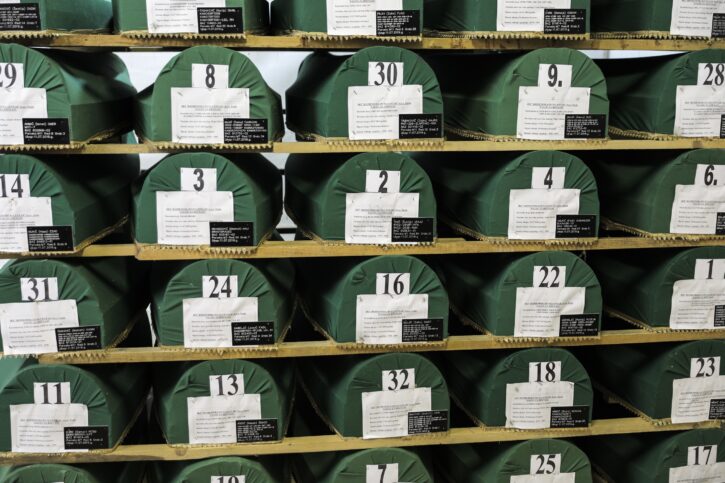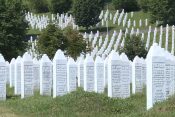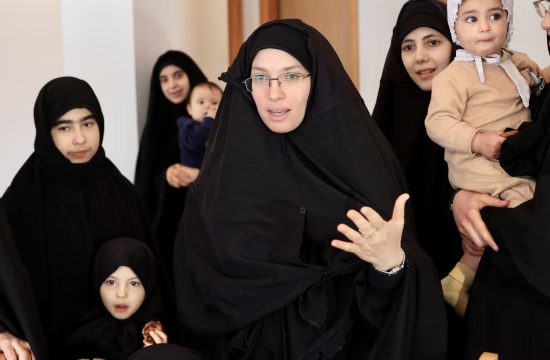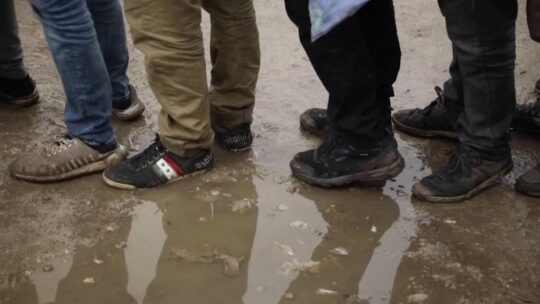
Green caskets containing the remains of 33 victims are stacked up at the morgue in the central Bosnian town of Visoko, ready to be transported and buried during next week’s commemoration of the Srebrenica genocide.
On July 11, 1995, Bosnian Serb forces overran the eastern Bosnian enclave and rounded up the town’s Muslim Bosniaks, separated men from women and little children and systematically executed some 8,000 men and boys.
Forensic experts excavate the victims and identify the bones through DNA analysis before putting skeletons together like jigsaw puzzles and returning the bodies to the families. Those rebury them every year on July 11 at the Memorial Centre’s cemetery near Srebrenica.
Some of the 33 victims to be buried this year were related. Among them are Saha Cvrk and her son Resid, Zaim Pilav and his son Fuad, brothers Fahrudin (25) and Zijo Mujic (28) and brothers Asim (20) and Kasim Isakovic (22).
The youngest of them is Osman Cvrk, born in 1979. He was 16 years old at the time of his death. His remains were found in several mass graves in the area of Srebrenica because after perpetrators initially buried the victims, they dug up the bodies and reburied them at other locations in an effort to cover up the crime.
This was mostly done with bulldozers and the machines tore up the bodies while loading them on trucks to be transported to some other location. By the time the remains were reburied into another mass grave, the bodies were a simple mix of people’s bones.
The 33 caskets are ready for the funeral, according to the director of the cemetery in Visoko, Kenan Karavdic.
“Unfortunately there are fewer victims identified each year. The searching process is very difficult and a lot of time has passed,” he said.
There are another 140 identified partial remains shelved up in the premises of the Podrinje Identification Project (PIP) in the northeastern town of Tuzla. However, the families of these victims refuse to bury them in hope more body parts will be found, Karavdic explained.
He appealed to the families to bury their loved ones as “it is better for them to have their grave, their tombstone, where a ‘Fatiha’ can be prayed than for them to be shelved up in the centre in Tuzla.”
As more parts are discovered each year, a ‘reassociation’ process takes place and the new remains are buried with the rest.
“This year there will be 129 such cases, it may be the biggest reassociation process until now, which shows that it is right to bury an incomplete body. But it will be the smallest funeral considering the number of the victims,” Karavdic said.
“This year, looking at the list, we can see that a lot of people with the last name Cvrk were killed, which is not unusual,” he added.
Each year, the trucks carrying the remains are greeted by scores of citizens who come to pay their respects.
“I would like to thank the citizens of Sarajevo, Ilijas and Vogosca who come out in large numbers, regardless of whether it is a working day or not, if it is sunny or raining, to welcome the convoy,” he said.
Two international courts, The International Criminal Tribunal for the Former Yugoslavia and the International Court of Justice ruled that the massacre was an act of genocide.
Currently, there are 6,610 genocide victims buried in the Srebrenica – Potocari Memorial Centre, and another 1,000 Srebrenica citizens are still to be found.
The remains were found in some 150 different locations, including more than 80 mass graves.
The youngest of all is Fatima Muhic, not a day old. The oldest is Saha Izmirlic, who was born in 1901.





